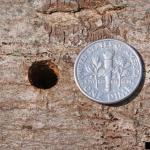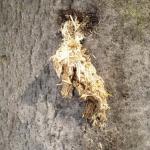A monthly e-newsletter from UMass Extension for landscapers, arborists, and other Green Industry professionals, including monthly tips for home gardeners.
To read individual sections of the message, click on the section headings below to expand the content:
UMass Labs Reopen
Plant Diagnostic Laboratory
The UMass Plant Diagnostic Laboratory has reopened as of June 22 for plant disease, insect pest and invasive plant/weed samples. At this time, we can only accept mail-in samples, walk-in samples cannot be accepted. Please refer to our website for instructions on sample submission and to access the submission form: https://ag.umass.edu/services/plant-diagnostics-laboratory. Mail delivery services and staffing have been altered due to the pandemic, so please allow for some additional time for samples to arrive at the lab and undergo the diagnostic process. We look forward to resuming activities and diagnosing your plant problems!
UMass Soil & Plant Nutrient Testing Lab
The UMass Soil & Plant Nutrient Testing Lab is pleased to announce that they will be accepting new orders for Routine Soil Analysis and Particle Size Analysis orders ONLY, beginning Monday, July 13. Please do not send orders for other types of analyses at this time. Orders should be sent via USPS, UPS, FedEx or other private carrier. The lab office will remain closed to the general public until further notice and hand delivered orders will not be accepted at this time. Processing time will be longer than usual since the lab is operating with reduced staff and staggered shifts. Updates and order forms are available at: https://ag.umass.edu/services/soil-plant-nutrient-testing-laboratory.
TickReport at the UMass Laboratory of Medical Zoology
The TickReport Risk Assessment & Passive Surveillance Program is open and tick samples can be submitted via https://www.tickreport.com. Please contact TickReport with tick-related questions and updates on the status of their service.
Paycheck Protection Program (PPP) Updates
The Paycheck Protection Program (PPP) has reopened the application period until August 8, 2020. The original PPP application period closed on June 30, 2020. All indications are that operations with hired labor would benefit from participating in the PPP.
As a recap, PPP is a program available to businesses including nursery and greenhouse operations that can cover payroll and other operating expenses. It is administered by the U.S. Small Business Administration (SBA) with applications being processed through an SBA-approved lending institution. While PPP is a loan, an important point to note is that the loan will be fully forgiven if the funds are used for payroll costs, interest on mortgages, rent, and utilities (at least 60% of the forgiven amount must have been used for payroll). Forgiveness is based on the employer maintaining or quickly rehiring employees and maintaining salary levels. Forgiveness will be reduced if full-time headcount declines, or if salaries and wages decrease. The period used to cover eligible costs and expenses has also increased from 8 weeks to 24 weeks from loan disbursement, making it easier for PPP recipients to meet the 60% payroll requirement. Special consideration under PPP is provided for seasonal businesses such as farming, nursery, greenhouse, and aquaculture operations.
More detailed information, including a list of SBA-approved lending institutions that process PPP applications can be found at: https://www.sba.gov/funding-programs/loans/coronavirus-relief-options/paycheck-protection-program.
PPP is a program you should definitely look into if you employ outside labor on your operation!
Tom Smiarowski, UMass Extension Risk Management/Crop Insurance Educator
MA Pesticide License Info: Licenses, Study Manuals, and Exams
PESTICIDE LICENSE EXAMS - The MA Dept. of Agricultural Resources (MDAR) has begun opening dates to hold exams for new exam applicants. Individuals will be able to begin signing up for new exams beginning 7/9/20. The exams will be held at the Colonial Inn in Gardener under a covered tent. Safety precautions will be sent to the examinees ahead of time so that they can be prepared when coming to the exam site. Please be aware that space is still limited, but MDAR is continuing to work on an online exam process, and will be adding some additional dates for the beginning of August. Safety of examinees and MDAR employees has been their priority when organizing this. I will continue to provide you with updates when we have them. To register, go to https://www.mass.gov/pesticide-examination-and-licensing.
PESTICIDE EXAM PREPARATION WORKSHOPS - The UMass Extension Pesticide Education Program is offering these workshops to help applicants prepare to take the Massachusetts Pesticide Applicator's License exam. Topics covered: Pest Identification, Pesticide Types and Formulations, Pesticides and Human Health, Pesticide Label, Pesticides and the Environment, Integrated Pest Management, Pesticide Laws and Regulations, and Practice Exam. For more information, go to https://www.umass.edu/pested/training_workshops/registration_form13.htm.
PESTICIDE MANUALS – To order a copy to study prior to taking the exam, go to https://www.umass.edu/pested/study_materials/index.htm.
RECERTIFICATION CREDITS - UMass Extension's Pesticide Education Program will resume offering online workshops in the fall that offer recertification credits. For info on how to register for these, go to https://www.umass.edu/pested/recertification/current_workshops.htm.
For holders of Massachusetts pesticide licenses whose current three-year retraining or recertification cycle ends on 7/1/20, the MDAR Pesticide Program has extended the time permitted to earn credits to 12/31/20 as well as the number of computer-based or online credits that are acceptable for these specific individuals. This means that individuals with a three-year retraining cycle ending on 7/1/20 may obtain any portion or all of the needed training credits from online sources and have until 12/31/20 to do it. For more information, go to https://www.mass.gov/doc/pesticide-license-recertification-processes-and-related-impacts-from-covid-19/download
TEMPORARY LICENSES - If your pesticide license has expired and you are unable to re-take the pesticide exam in 2020, the Mass. Dept. of Agricultural Resources will issue temporary pesticide licenses, without an exam, if certain criteria are met. For an individual with an expired license who wants to obtain a temporary Massachusetts Pesticide Applicator License, the license must have an expiration date of December 31, 2017 or after; the license was in good-standing when it expired; and the applicator has not had a pesticide violation within the past three (3) years; among other criteria. This significantly impacts pest control services; especially, seasonal businesses such as lawn care and mosquito and tick services. For more info on this update, go to https://www.mass.gov/guides/covid-19-resources-for-agriculture under Addressing COVID-19 Impacts, Bulletins and Guidance. You can find the specific bulletin at https://www.mass.gov/doc/mdar-bulletin-17-temporary-pesticide-license/download. These temporary licenses will expire on December 31, 2020. If you will want to be licensed in 2021, you will be required to take the pesticide exam.
Hot Topics
Perennials and Drought Stress
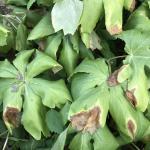 A crop consultant once said to me, “Watering keeps plants alive, but rain makes them grow.” It’s true that there is something about a good steady rain that irrigation just cannot equal. Many parts of the Northeast experienced intense drought in June, and even with supplemental watering, landscape perennials may still display symptoms of stress under such conditions. Plants react to drought stress by closing their stomata in order to slow transpiration. This allows the plant to conserve water, but the concurrent reduction in carbon dioxide uptake inhibits photosynthesis. These factors reduce growth and nutrient uptake, resulting in stunted plants. Leaves may turn yellow or show marginal browning. Plants may set fewer flowers. Perennials that normally die back in late summer may disappear earlier than normal.
A crop consultant once said to me, “Watering keeps plants alive, but rain makes them grow.” It’s true that there is something about a good steady rain that irrigation just cannot equal. Many parts of the Northeast experienced intense drought in June, and even with supplemental watering, landscape perennials may still display symptoms of stress under such conditions. Plants react to drought stress by closing their stomata in order to slow transpiration. This allows the plant to conserve water, but the concurrent reduction in carbon dioxide uptake inhibits photosynthesis. These factors reduce growth and nutrient uptake, resulting in stunted plants. Leaves may turn yellow or show marginal browning. Plants may set fewer flowers. Perennials that normally die back in late summer may disappear earlier than normal.
Even though watering can’t fully replace a good soaking rain, watering your perennial beds will certainly help ease drought stress. As a rule of thumb, most perennials with well-established root systems require about one inch of water weekly in the absence of rain. Plants spending their first year in the soil will require more water more frequently until they are established. Use drip irrigation or a sprinkler as opposed to hand watering: the gradual application of water leads to better soil penetration and less run-off. Resist the urge to overwater. Soil should be moist but not completely saturated.
Other drought stress management tactics include:
- Manage weeds, which compete with perennials for water and nutrients.
- Manage insect pests and diseases that may further weaken plants.
- Cut back on fertilizer. Drought stressed plants have a diminished capacity for nutrient uptake. While it is important to maintain adequate fertility, excessive nitrogen applied in drought conditions only adds to plant stress. If nitrogen application is necessary, avoid quick-release forms and avoid fertilizers with a high concentration of salts.
- Add organic matter to increase water retention capacity of soil.
- Add mulch. Most organic mulches applied in spring have degraded somewhat by mid-summer and may need to be replenished.
Angela Madeiras, UMass Extension Diagnostic Technician: Floriculture, Vegetable Crops, and Turf
Questions & Answers
Q. I have a Kousa dogwood on which the leaves are curled and brown at the edge. Is this a disease and is there a control for it?
A. The problem is likely leaf scorch, a common physiological problem typically caused by environmental conditions. Leaf scorch occurs when water loss through transpiration exceeds the ability of a plant to take up water through the root system. In many plants, this causes leaves to curl and become necrotic or dead along the edges of the leaf or at the leaf tip.
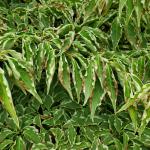 Leaf scorch can be caused by transplanting, root damage because of excavation, soil compaction, over fertilization, high soil salts, and environmental conditions. The environmental conditions include hot weather, low soil moisture, and windy conditions. Leaf scorch as a result of environmental conditions is being seen a lot in the landscape right now due to low soil moisture and hot windy days. The symptoms may look similar to some diseases such as anthracnose or bacterial leaf scorch. Making the distinction between disease or an environmental condition is important. Physiological leaf scorch will typically be uniform across the plant or parts of the plant with greater exposure. Symptoms on the leaf will also be uniform, with leaf roll and necrotic or brown edges of the leaf and tip. Consider submitting samples to the UMass Plant Diagnostic Lab if unsure: https://ag.umass.edu/services/plant-diagnostics-laboratory.
Leaf scorch can be caused by transplanting, root damage because of excavation, soil compaction, over fertilization, high soil salts, and environmental conditions. The environmental conditions include hot weather, low soil moisture, and windy conditions. Leaf scorch as a result of environmental conditions is being seen a lot in the landscape right now due to low soil moisture and hot windy days. The symptoms may look similar to some diseases such as anthracnose or bacterial leaf scorch. Making the distinction between disease or an environmental condition is important. Physiological leaf scorch will typically be uniform across the plant or parts of the plant with greater exposure. Symptoms on the leaf will also be uniform, with leaf roll and necrotic or brown edges of the leaf and tip. Consider submitting samples to the UMass Plant Diagnostic Lab if unsure: https://ag.umass.edu/services/plant-diagnostics-laboratory.
Leaf scorch can occur on just about any plant, however, it is commonly seen on dogwoods, maples, rhododendron, and viburnum. If leaf scorch is caused by environmental conditions, including low soil moisture, water your plants deeply once a week or every other week to alleviate plant stress. Using a mulch over the root zone and reducing competition for soil moisture from other plants like grasses can also help.
Q. There are several species of plants in my yard that are covered with a black mold-like substance. Is it damaging my plants?
A. The black mold like substance is referred to as sooty mold. Sooty molds are types of fungi that feed on honeydew, the excrement of piercing sucking insects. Honeydew has lots of nutrients supporting the growth of the fungi.
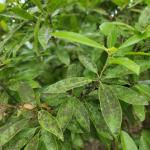 Though sooty molds are not plant pathogens, the molds can impact plant health by reducing photosynthesis. In most cases however, the sooty mold is an aesthetic issue. When honeydew is fresh, it may be be washed off; however, once the mold has started to grow, removal from plants is unlikely. Sooty mold can also cover other objects like cars, fences, windows, etc. To remove from hard, non-plant surfaces, soapy water and brushing are necessary.
Though sooty molds are not plant pathogens, the molds can impact plant health by reducing photosynthesis. In most cases however, the sooty mold is an aesthetic issue. When honeydew is fresh, it may be be washed off; however, once the mold has started to grow, removal from plants is unlikely. Sooty mold can also cover other objects like cars, fences, windows, etc. To remove from hard, non-plant surfaces, soapy water and brushing are necessary.
To control sooty mold, the insect producing the honeydew must be identified. Insects that commonly produce honeydew include aphids, mealybugs, or scale insects. The insect may be on the plant experiencing the sooty mold or on other nearby plants. Often times the sooty mold is found on understory plants and the insect can be found feeding above in the canopy. On Cape Cod, there has been a widespread occurrence of lecanium scale. This scale insect creates copious amounts of honeydew and thus sooty mold, and can be found feeding on many species of trees and shrubs. However, white oaks seems to be the favored host, leaving the plants underneath covered in sooty mold. Once the insect has been identified, the decision about appropriate management can be made.
Russ Norton, Horticulturist, Cape Cod Cooperative Extension
Trouble Maker of the Month
An Important Reminder: Asian Longhorned Beetle is Not a Thing of the Past
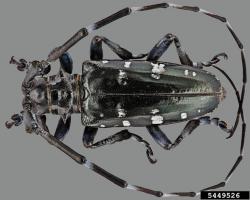 Recently, we’ve received an important reminder that Asian longhorned beetle (Anoplophora glabripennis) has not disappeared. The USDA-APHIS announced on June 15, 2020 that the Asian longhorned beetle has been detected in yet another state: South Carolina.
Recently, we’ve received an important reminder that Asian longhorned beetle (Anoplophora glabripennis) has not disappeared. The USDA-APHIS announced on June 15, 2020 that the Asian longhorned beetle has been detected in yet another state: South Carolina.
Asian longhorned beetle eradication programs currently exist in Massachusetts, New York, and Ohio. A homeowner is responsible for finding, reporting, and making officials aware of the infestation in South Carolina. Great job!
The U.S. Department of Agriculture’s (USDA) Animal and Plant Health Inspection Service (APHIS) and the Clemson University’s Department of Plant Industry (DPI) are inspecting trees in Hollywood, South Carolina following the detection and identification of the Asian longhorned beetle (ALB).
On May 29, a homeowner in Hollywood, South Carolina contacted DPI to report they found a dead beetle on their property and suspected it was ALB. A DPI employee collected the insect the same day and conducted a preliminary survey of the trees on the property. Clemson’s Plant and Pest Diagnostic Clinic provided an initial identification of ALB, and on June 4, APHIS’ National Identification Services confirmed the insect. On June 11, APHIS and DPI inspectors confirmed that one tree on the property is infested, and a second infested tree was found on an adjacent property. For more information, visit: https://www.aphis.usda.gov/aphis/newsroom/stakeholder-info/sa_by_date/sa-2020/sa-06/alb-sc .
This is a perfectly timed reminder for us to remain vigilant, and report any suspicious beetles or damage to trees, especially maples, in Massachusetts. Asian longhorned beetle infests 12 genera of trees, however maples are preferred hosts. Potential hosts for ALB include those in the following genera:
- Ash (Fraxinus)
- Birch (Betula)
- Elm (Ulmus)
- Golden raintree (Koelreuteria)
- Horsechestnut and Buckeye (Aesculus)
- Katsura (Cercidiphyllum)
- London planetree and Sycamore (Platanus)
- Maple (Acer)
- Mimosa (Albizia)
- Mountain Ash (Sorbus)
- Poplar (Populus)
- Willow (Salix)
Look for the signs of an ALB infestation which include perfectly round exit holes (about the size of a dime), shallow oval or round scars in the bark where a female has chewed an egg site, or sawdust-like frass (excrement) on the ground nearby host trees or caught in between branches. Be advised that other, native insects may create perfectly round exit holes or sawdust-like frass, which can be confused with signs of ALB activity. However, if you see suspicious damage (especially on maple), please report it.
Starting in July, it is possible that adult Asian longhorned beetles may be emerging in Massachusetts. Therefore, now is the time to report any suspicious beetles. A common look-alike for the Asian longhorned beetle is the native white spotted pine sawyer (WSPS). You can look for the key difference between WSPS and ALB adults, which is a white spot in the top center of the wing covers (the scutellum) on the back of the beetle. White spotted pine sawyer will have this white spot, whereas Asian longhorned beetle will not. Both insects can have other white spots on the rest of their wing covers; however, the difference in the color of the scutellum is a key characteristic. White spotted pine sawyers are associated with declining pine trees and are typically not considered to be pests.
The regulated area for Asian longhorned beetle in Massachusetts is 110 miles2 encompassing Worcester, Shrewsbury, Boylston, West Boylston, and parts of Holden and Auburn. If you believe you have seen damage caused by this insect, such as exit holes or egg sites, on susceptible host trees like maple, or have captured or photographed a suspicious beetle, please call the Asian Longhorned Beetle Eradication Program office in Worcester, MA at 508-852-8090 or toll free at 1-866-702-9938.
To report an Asian longhorned beetle find online or compare it to common insect look-alikes, visit: http://massnrc.org/pests/albreport.aspx or https://www.aphis.usda.gov/pests-diseases/alb/report .
For more information about Asian longhorned beetle in Massachusetts, visit the UMass Extension ALB Fact Sheet.
Tawny Simisky, Extension Entomologist, UMass Extension Landscape, Nursery, & Urban Forestry Program
Garden Clippings Tips of the Month
July is the time to:
- New to gardening? Check out the weekly articles in our new series, Food Gardening in Massachusetts 2020. In these uncertain times, growing your own food is appealing as a way to help alleviate food insecurity, do something fun that is compatible with social distancing, and produce healthy and nutritious food! UMass Extension authors Frank Mangan and Heriberto Godoy-Hernandez offer this series of weekly articles which provide research-based information in English and Spanish on how to grow your own vegetables and herbs in Massachusetts.
- Vegetable growing fact sheets. UMass Extension also has a number of useful fact sheets on growing vegetables at https://ag.umass.edu/resources/home-lawn-garden/fact-sheets/vegetables.
- Deadhead perennials. Deadheading perennials helps to keep the plant tidy but also encourages rebloom of some species such as Salvia.
- Keep up with landscape and garden maintenance. Keep weeding, maintain annuals, and divide spring blooming perennials.
- Harvest veggies, fruit, and herbs from your garden. Enjoy now or freeze what you can to be enjoyed later in the year.
- Leaves of three leave them be – or better yet get rid of them! Be on the lookout for and manage poison ivy in the landscape. Be sure to wear gloves or use tools to remove and dispose of plants.
- Follow local water regulations and water as efficiently as possible. When you need to and can irrigate, make sure your applications count!
- Don’t irrigate midday. Evaporation is greatest midday, which could mean that much of the water being applied is lost before it reaches your plants! Wind also contributes to evaporation and can change irrigation spray patterns. Early morning and evening are the best times to irrigate.
- Use drip irrigation or soaker hoses when possible. Overhead irrigation frequently results in watering non-plant surfaces and can result in water interception by plant canopies which can reduce the water that reaches the plants’ root systems.
- Maintain your irrigation system. Check for leaks, broken spray heads, and perform an irrigation system audit to assure uniformity.
- Use smart technology. Smart controllers can monitor soil moisture and use environmental conditions to adjust irrigation based on water being lost to evapotranspiration (evaporation plus transpiration).
- Water deeply, allowing water to soak into the ground. Irrigating slowly (via drip irrigation or a slow flow) is key to achieving infiltration vs. runoff. Newly installed plants will need more frequent irrigation until established, especially container grown plants that were produced in soilless substrates. Less frequent, deeper irrigation encourages good root growth which will help plants survive water stress.
- Apply mulch to planting beds and in tree rings 2-4” deep. Keep mulch away from the base of plants. Mulch helps reduce evaporation, insulates plant roots, and can add organic matter to the soil.
- Raise your mower blade. Longer grass promotes deeper roots and a more drought-resistant lawn.
- Reduce the competition for water by controlling weeds.
- Don’t apply fertilizer under drought conditions. High fertilizer concentration can make what water is available unavailable to plants. Fertilization will also result in increased growth which increases the water demand.
- Keep in mind that landscapes typically require one inch of water per week (including rainfall). Unsure of what your system or sprinkler is applying? You can use a rain gauge and see how much water is collected in a certain period of time (30 minutes for example). Use multiple rain gauges if possible to understand if you have good uniformity, or make sure the rain gauge is located in an “average area”.
Mandy Bayer, Extension Assistant Professor of Sustainable Landscape Horticulture
The Research Buzz
This article is an excerpt from “The Research Buzz” – a quarterly column summarizing the latest in honey bee research. It is published in the Massachusetts Beekeeping Association newsletter, and also on the UMass Extension website. You can read the full article here.
Woody Ornamentals are Best for Bees
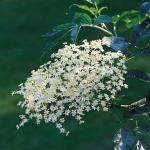 Ornamental flowers can be showy but may not be attractive or nutritious to bees. In order to explore the potential benefits (or lack thereof) of ornamental plants to bees, a multi-university group recently placed honey bee colonies in commercial nurseries and tracked which plants they visited. They found that bees collected very little pollen from herbaceous ornamentals, but gathered copious pollen from some ornamental trees, shrubs and woody vines (such as hydrangea, holly, rose, elderberry, lilac and viburnum). The hives also gathered lots of pollen from plants outside the nursery, including trees (maple, beech, oak, willow), woody plants (sumac, holly), weeds (clover, mustards, plantain), and a variety of fall asters.
Ornamental flowers can be showy but may not be attractive or nutritious to bees. In order to explore the potential benefits (or lack thereof) of ornamental plants to bees, a multi-university group recently placed honey bee colonies in commercial nurseries and tracked which plants they visited. They found that bees collected very little pollen from herbaceous ornamentals, but gathered copious pollen from some ornamental trees, shrubs and woody vines (such as hydrangea, holly, rose, elderberry, lilac and viburnum). The hives also gathered lots of pollen from plants outside the nursery, including trees (maple, beech, oak, willow), woody plants (sumac, holly), weeds (clover, mustards, plantain), and a variety of fall asters.
Why is this research important? Previous research has found that most ornamentals are ignored by pollinators, but a few provide excellent forage. This study also found that most ornamentals were unattractive to pollinators – but that a handful of trees, shrubs, and woody vines (ornamental as well as wild) accounted for a disproportionate amount of collected pollen. There are two take-aways from this research: (1) if you are going to plant ornamentals for bees, woody plants are better for pollinators than showy forbs, and (2) wild trees, weeds and meadow flowers are important resources for bees, even in managed environments. Overall, there is a need for more research on the value of ornamental (and wild) plants for bees in urban and suburban habitats. Read the full study here.
Bumble Bees Damage Leaves to Induce Early Flowering
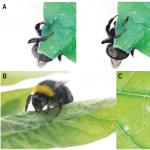 A research group from France and Switzerland recently published a startling discovery in Science: when workers from a common European bumble bee species (Bombus terrestris) are pollen-deprived, they will damage plant leaves in order to induce early flowering. The study was inspired when the researchers casually observed bumble bees chewing holes in plants. They subsequently conducted a series of experiments and found that bumble bee colonies that were deprived of pollen were more likely to damage plant leaves, and that plants with bee-chewed leaves flowered significantly earlier (30 days on average!) than plants that were mechanically damaged or left undisturbed. This behavior was observed in two other bumble bee species, but not in honey bees.
A research group from France and Switzerland recently published a startling discovery in Science: when workers from a common European bumble bee species (Bombus terrestris) are pollen-deprived, they will damage plant leaves in order to induce early flowering. The study was inspired when the researchers casually observed bumble bees chewing holes in plants. They subsequently conducted a series of experiments and found that bumble bee colonies that were deprived of pollen were more likely to damage plant leaves, and that plants with bee-chewed leaves flowered significantly earlier (30 days on average!) than plants that were mechanically damaged or left undisturbed. This behavior was observed in two other bumble bee species, but not in honey bees.
Why is this research important? We know that stress (such as herbivory by insects) affects flowering phenology. However, this is the first evidence that some bee species directly manipulate plants in order to accelerate flowering when forage is scarce. As climate change alters the phenology of both plants and their insect pollinators, this behavior could become increasingly important to help Bombus terrestris align flowering times with resource needs. Read the full study here.
Hannah Whitehead, UMass Extension Honeybee Educator
Upcoming Events
Operations at the University of Massachusetts Amherst have been curtailed in response to the COVID-19 pandemic and no in-person UMass Extension events are planned at this time. Our professional staff continue to work remotely to maintain and expand our online educational services. For more details for any of these events, go to the UMass Extension Landscape, Nursery, and Urban Forestry Program Upcoming Events Page.
Tune in to a TickTalk with TickReport Webinars
This is a FREE live webinar series by Dr. Stephen Rich, Director of the UMass Laboratory of Medical Zoology held noon to 1:00 pm on the 2nd Wednesday of the month. Co-sponsored by UMass Extension and the UMass Laboratory of Medical Zoology.
- July 8 - Biology of Powassan and Other Tick-borne Viruses
Dr. Stephen Rich, Professor of Microbiology and Director of the UMass Laboratory of Medical Zoology, and Dr. Saravanan Thangamani, Professor of Microbiology and Immunology at Upstate Medical University in Syracuse, NY discuss what is currently known about tick-borne viruses, including Powassan virus. Dr. Thangamani studies the serosurveillance of vector-borne (tick and mosquito) diseases including the effect of co-infection on the clinical outcome of Lyme disease and Powassan encephalitis. Register at https://ag.umass.edu/landscape/education-events/webinars
- Aug-Dec: noon to 1:00 pm on the 2nd Wednesday of the month, topics TBA.
Invasive Insect Webinars
Did you miss our recent webinar series focusing on the impact, monitoring, and management of invasive insects? Find recordings of these webinars at https://ag.umass.edu/landscape/education-events/invasive-insect-webinars. Topics include the spotted lanternfly, spotted wing drosophila, brown marmorated stink bug, emerald ash borer, gypsy moth, winter moth, and Asian longhorned beetle.
InsectXaminer!
This short video series hopes to increase the visibility of the beautiful world of insects, even those we consider to be pests in our managed landscapes. Episodes so far featuring Gypsy Moth, Lily Leaf Beetle, and Euonymus Caterpillar can be found at: https://ag.umass.edu/landscape/education-events/insectxaminer
Invasive Plant Management Certification series
The remaining three classes in this series will be held as live Zoom meetings. For info on how to register, contact Ellen Weeks at eweeks@umext.umass.edu.
- 7/23 - State Regulations Pertaining to Invasive Plant Management (part A2: Invasive Plant Management Certification Program)
- 8/5 - The Invasive Plant Issue and Invasive Plant Identification (part A3: Invasive Plant Management Certification Program)
- 8/19 - Developing an Invasive Plant Management Program (part B: Invasive Plant Management Certification Program)
Green School
Green School will be held virtually in 2020, so it will be accessible from anywhere with an Internet connection! More details and registration coming soon at https://ag.umass.edu/landscape/education/umass-extensions-green-school. Classes will be held 10/26 to 12/10.
Pesticide Exam Preparation and Recertification Courses
These workshops have been converted to a remote/online format. Contact Natalia Clifton at nclifton@umass.edu or go to https://www.umass.edu/pested/training_workshops for more info.
Additional Resources
For detailed reports on growing conditions and pest activity – Check out the Landscape Message
For commercial growers of greenhouse crops and flowers - Check out the New England Greenhouse Update website
For professional turf managers - Check out our Turf Management Updates
For home gardeners and garden retailers - Check out our home lawn and garden resources. UMass Extension also has a Twitter feed that provides timely, daily gardening tips, sunrise and sunset times to home gardeners at twitter.com/UMassGardenClip
Food Gardening in Massachusetts 2020
With the uncertainties around the Coronavirus (COVID-19) and the economy, growing your own food is appealing as a way to help alleviate food insecurity, do something fun that is compatible with social distancing, and produce healthy and nutritious food! To become a successful gardener is not complicated; for the most part, the needed skills can be easily mastered. Join us for this series of weekly articles which with provide research-based information on how to grow your own vegetables and herbs in Massachusetts.
Some of the content has been adapted from the New England Vegetable Management Guide, a collaborative effort by members of the Extension Vegetable Programs of the New England states. These articles are written by Frank Mangan, Extension Professor of Vegetable Crops at the UMass Stockbridge School of Agriculture, and his Ph.D. student, Heriberto Godoy Hernandez, and are available in both English and Spanish. Additional expertise on specific topics is provided by UMass Extension Specialists.
Growing Your Own Food with Franco and Beto (Columna de Franco y Beto sobre el cultivo de sus propias hortalizas y hierbas aromáticas en Massachusetts) is available here: https://ag.umass.edu/resources/home-lawn-garden/food-gardening-in-massachusetts-2020
Diagnostic Services
Landscape and Turf Problem Diagnostics - The UMass Plant Diagnostic Lab has reopened as of 6/22/20 for plant disease, insect pest and invasive plant/weed samples. At this time, we can only accept mail-in samples; walk-in samples cannot be accepted. The lab serves commercial landscape contractors, turf managers, arborists, nurseries and other green industry professionals. It provides woody plant and turf disease analysis, woody plant and turf insect identification, turfgrass identification, weed identification, and offers a report of pest management strategies that are research based, economically sound and environmentally appropriate for the situation. Accurate diagnosis for a turf or landscape problem can often eliminate or reduce the need for pesticide use. Please refer to our website for instructions on sample submission and to access the submission form at https://ag.umass.edu/services/plant-diagnostics-laboratory. Mail delivery services and staffing have been altered due to the pandemic, so please allow for some additional time for samples to arrive at the lab and undergo the diagnostic process.
Soil and Plant Nutrient Testing - The UMass Soil and Plant Nutrient Testing Lab resumes accepting new orders for routine soil analysis and particle size analysis orders ONLY, beginning Monday, 7/13/20. Please do not send orders for other types of analyses at this time. Orders should be sent via USPS, UPS, FedEx or other private carrier. The lab office will remain closed to the general public until further notice and hand delivered orders will not be accepted at this time. Processing time will be longer than usual since the lab is operating with reduced staff and staggered shifts. Testing services are available to all. The lab provides test results and recommendations that lead to the wise and economical use of soils and soil amendments. For updates and order forms, visit the UMass Soil and Plant Nutrient Testing Laboratory web site.
TickReport Update - The TickReport Risk Assessment & Passive Surveillance Program is open and tick samples can be submitted via https://www.tickreport.com. Please contact TickReport with with tick-related questions and updates on the status of their service.
